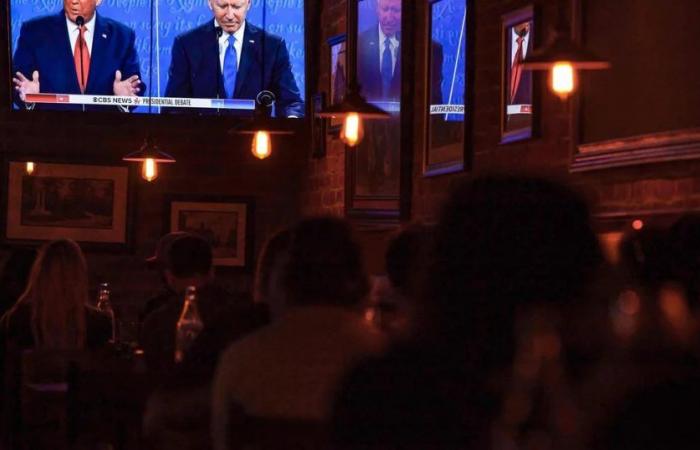Television debates are already inextricably linked to electoral campaigns in the United States and represent a fundamental pillar within the campaign strategies of the two major parties. More than six decades after the first face to face, starring John F. Kennedy and Richard Nixon, the confrontations between Joe Biden and Donald Trump will be reissued. Some 70 million people followed on television in 1960 the debate between the then vice president of the United States, Nixon, and the Democratic candidate, Kennedy. The latter’s charisma and image tipped the balance in his favor – he ended up winning the elections – since analysts ruled that Nixon, who was still recovering from a hospital admission, had taken its toll. aspect of him. We would have to wait 16 years for the next debate. In 1976, Democrat Jimmy Carter faced the then president, Gerald Ford, who left a phrase for history: “There is no Soviet domination in Eastern Europe and there never will be under the Ford Administration.” For the first time, in that campaign the candidates for the Vice Presidency from each of the major parties also faced each other, a formula that would be replicated in subsequent decades and that also grants a leading role to the ‘number two’, called to automatically succeed the president in case of resignation, dismissal or death. Carter repeated it four years later, this time with Republican Ronald Reagan opposite. More than eighty million people sat in front of the television, which gave the event a record audience figure that was not surpassed until 2016. Reagan’s age was one of the big issues that hovered over his re-election campaign in 1984 – -he was 73 years old–, but the president knew how to play it in his favor against the Democrat Walter Mondale. “I’m not going to take advantage of my rival’s youth and inexperience for political reasons,” said Reagan, who was re-elected. In 1988, there were two debates between the candidates, George HW Bush and Michael Dukakis, and the era of the Commission on Presidential Debates began, an independent organization that has since set the standard for televised confrontations. THE DECADE OF THE NINETY In 1992, what remains to be remembered is the look that Bush took at his watch in the midst of a debate with the Democratic candidate, Bill Clinton, who would end up winning the elections and repeating in 1996. On his second date, the already president Clinton insulted her rival Bob Dole’s “age of his ideas” in a campaign in which the Republican candidate’s 73 years of age was also a matter of debate. The Bush surname returned in 2000, thanks to George W. Bush, who managed to defeat Al Gore in the elections that year. Clinton’s vice president sighed openly and rolled his eyes at the statements of his rival in the first of the debates, gestures that were even ridiculed on comedy shows. In 2004, it was John Kerry’s turn on the Democratic side, who despite trying to use the debates to present a solvent program in multiple areas, could not unseat the then occupant of the White House, thus completing Bush’s eight years of office. mandate. THE OBAMA ERA The 21st century saw the emergence of the Internet into the lives of ordinary citizens, but it would not be until the 2008 campaign when the power of social networks became palpable, which Senator Barack Obama knew how to use to his advantage. to win a solid victory against fellow Congressman John McCain. The Obama effect was noticeable in the audience figures, but the peak of viewers would be the ‘face to face’ of the Vice Presidential candidates -almost 70 million-. The protagonists were Sarah Palin, immersed in all kinds of controversies, and Joe Biden, now president of the United States. The Obama-Biden tandem repeated – and won again – in 2012. Opposite was Mitt Romney, criticized after stating in a debate that he had “folders full of women” who could enter his Government as an argument to deny wage discrimination due to gender reasons. AUDIENCE RECORD In 2018, expectation for the campaign skyrocketed again, as demonstrated by the fact that 84 million people watched the first face-to-face between Donald Trump and Hillary Clinton, a record that to this day has not been surpassed and which does not include viewers who were able to follow it online. Already in these debates, Trump avoided clarifying whether he would respect the results in case of defeat and did not hesitate to stir up Bill Clinton’s past to contain criticism of misogyny. “What a disgusting woman,” the tycoon, who won the elections despite the fact that Hillary Clinton obtained more votes, snapped in one of these meetings. Trump also went on the attack in 2022, with interruptions and personal allusions against Biden that ended up taking their toll on him. The campaign was organized in the middle of the COVID-19 pandemic and, in fact, the Republican resigned from the second debate when he was still recovering from this illness when he learned that it would be virtual. A FIRST DEBATE BETWEEN WOMEN Aside from the presidential duels, and despite the impact that the Kennedy-Nixon face-to-face has had on the collective imagination, this was not the first political debate broadcast on American television, since in 1956 there was a first attempt starring two women. That year the polls pitted Democrat Adlai Stevenson and Republican Dwight Eisenhower, but the parties turned not to the first swords but to two women: First Lady Eleanor Roosevelt represented the party that then held the Government, while Senator Margaret Chase Smith He did the same on the Democratic side.
For Latest Updates Follow us on Google News


